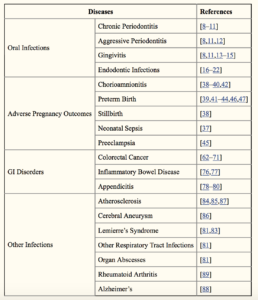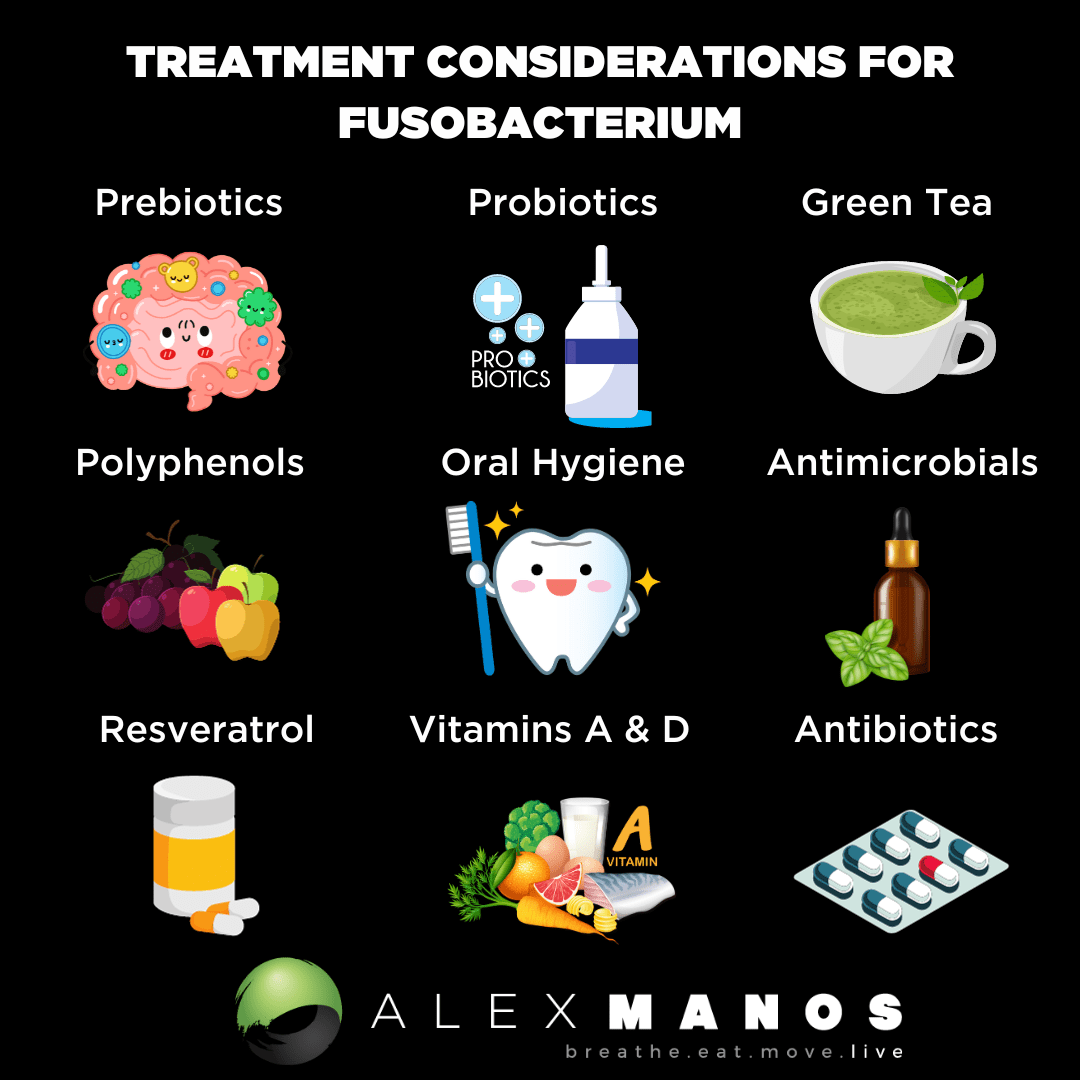In this blog entitled ‘Everything You Need To Know About Fusobacterium’ I am going to discuss the bacteria Fusobacterium with the aim of highlighting how this bacteria influences both health and disease.
Before we start, other blogs that you might be interested in, include:
- The Ultimate Guide To IBS
- SIBO: What Causes It
- Can the gut microbiome cause depression and changes in mood?
What Is Fusobacterium?
Fusobacteria are Gram-negative anaerobic bacilli with species-specific reservoirs in the human mouth, gastrointestinal tract and elsewhere. There are some known strains including:
- Fusobacterium nucleatum associated with colorectal cancer
- Fusobacterium necrophorum associated with Lemierre’s Syndrome
Fusobacterium nucleatum cdertainly has the most research behind it.
Where Does It Come From?
Fusobacterium is a natural coloniser of the oral and gut microbiome.
Background
Despite the diversity of bacterial life, much of microbiological research has focused for a long time on certain lineages, such as Proteobacteria, on the basis of their importance to human health and agriculture, novelty in metabolic capability and, to an extent, ease of study (for example, because of culturability and genetic tractability). Increasingly, omics data are demonstrating that our current focus within the microbial world is limited given the diversity of unexamined microorganisms and the potential roles of less-studied micro-organisms in human disease and the environment.
Fusobacteria, a distinct phylum of bacteria, are a prime example of previously understudied taxa.

Diseases F. nucleatum associated with. Curr Opin Microbiol. 2015 Feb; 0: 141–147.
Where Are Fusobacterium Found?
Fusobacterium species are found in the mouth and other mucosal sites of humans.
Their presence in these healthy tissues suggests that they are natural constituents of the microbiota at these sites. However, as they have been frequently isolated from these same and other tissues in clinical samples during active disease, they are regarded as opportunistic pathogens. Of those species that colonise humans, F. nucleatum is the most abundant in the oral cavity and has come to the forefront of scientific interest in the past decade because of an increasing number of associations with extra-oral diseases.
Whereas F. nucleatum has a mutualistic relationship with the other members of the oral microbiota, its interactions with human tissues — whether oral or extra-oral — span from neutral to pathogenic in nature. Although the oral biofilms it helps coordinate are found on tooth surfaces in healthy individuals, F. nucleatum is also important in periodontitis as it directly shapes host responses and increases the infectivity of other pathogens.
Fusobacteria And Oral Health
F. nucleatum can promote inflammatory responses, such as periodontitis.
The contribution of F. nucleatum to extra-oral diseases remains rather mechanistically speculative. Let’s take a look at the research…
Fusobacterium And Pregnancy
Adverse pregnancy outcomes, such as placental infections and pre-term birth, are the extra-oral diseases with the most data supporting a role for F. nucleatum as a driver or causative agent of disease.
Fusobacterium And Colorectal Cancer
Colorectal cancer (CRC) is the third most prevalent cancer in the world. There are many risk factors involved in CRC. According to recent findings, the tumour microenvironment and feces samples of patients with CRC are enriched by Fusobacterium nucleatum. Thus, F. nucleatum is proposed as one of the risk factors in the initiation and progression of CRC.
But wait one second! A key question is does fusobacterium cause CRC, or does it like the environment and thus thrive? In other words is it a cause or a consequence of the disease?
Fusobacterium: Friend, Associate, Or Foe?
The below quote answers this question for us:
Although a causal role cannot be ruled out, our observations, based on the faecal microbiome, support the hypothesis that Fusobacterium is a passenger that multiplies in the more favourable conditions caused by the malignant tumour rather than a causal factor in colorectal cancer development.
The detection of Fusobacterium spp. in healthy tissues raises the question of whether the frequency with which F. nucleatum is isolated from diseased placentae and amniotic fluid is due, in part, to sampling bias, as pathological tissues are more frequently examined than healthy placentae. Therefore, as in the oral cavity, F. nucleatum may prove to be pathogenic in the placenta only under certain conditions or by specific strains.
Fusobacterium And Inflammatory Bowel Disease (IBD)
IBD has been recognised as a risk factor for CRC. Thus, it is not surprising that the same microorganisms are implicated in both diseases. F. nucleatum has been detected in colonic biopsies of patients with IBD. F. nucleatum strains isolated from inflamed tissues of the IBD patients are more invasive than those from the normal tissues. Several studies have reported an association of F. nucleatum in appendicitis. Co-occurrence of F. nucleatum with other oral taxa has been observed.
The mechanisms of F. nucleatum in IBD and appendicitis have not been elucidated.
Fusobacterium And Hydrogen Sulfide
Numerous enzymes, identified as cysteine synthase, were involved in the production of H2S from cysteine and the expression varied among Fusobacterium spp. and strains.
How Do You Treat Fusobacterium?
Before diving in to treatment considerations it’s important to appreciate more context is required if we are going to have a high success rate. For example do you have fusobacterium nucleatum at elevated levels in the mouth? It has been discussed in the research, and I have seen clinically, that this can be the cause of elevated fusobacterium in the gut. And thus, if you don’t address this, you will never successfully address the imbalances in the gut. I speak about this in my podcast with Pete Williams, a renouned expert in the oral microbiome:
But let’s dive in to what we can do from a gut perspective
Antibiotics have been discussed in the research for fusonacterium nucleatum.
I would recommend focusing on the overall environment if you have a higher than normal level of fusobacterium. It may be a different question/answer when you know you have an infection with fusobacterium nucleatum.
Ultimately though our tool kit for modulating the microbiome includes:
- Probiotics both in dietary and supplement form
- Prebiotics both in dietary and supplement form
- Polyphenols (i.e a diet rich and diverse in fruit, vegetables, whole grain and other plants)
- Dietary fibre.
- Omega 3 fatty acids.
- Sunshine and time spent outdoors in nature.
- Socialising.
- Exercise
- Stress management and optimal sleep.
Oral Health
You may like to read my blog on Oral Health: A Key Determinant In Health.
But ensuring you have a good quality toothpaste, floss, and avoid over the counter mouthwashes will be important when considering the role that Fusobacterium can play in conditions like colorectal cancer and IBD.
Recommended Toothpaste
For my UK readers, I recommend Gutology mineral toothpaste, or/and, RiseWell Toothpaste.
For my US readers, I recommend Boka.
Green Tea
Green tea may be helpful based on one study:
Green tea liquid alters the salivary microbiota and reduces the functional pathways abundance relevant to carcinogenesis. Similar bacterial networks in faecal and salivary microbiota datasets comprising putative oral bacteria are found and Green tea liquid reduces the faecal levels of Fusobacterium
Probiotics
Probiotics have also been shown in the research to help modulate fusobacterium including Bifidobacterium longum and Lactobacillus acidophillus. I have had success with a range of products including:
- Recommend Product (U.K): Every day max
- Recommended Product (U.S.A): Probiotic-10
Prebiotics
Prebiotics have also been discussed and a frequent one recommended is:
Polyphenols
Polyphenols such as:
- Recommend Product (U.K): Bio.Me Essential
- Recommended Product (U.S.A): Polyphenols
References
- Symbiont, opportunist and oncobacterium: click here
- Periodontal health and disease: click here.
- An emerging gut pathogen?: click here.
- Colorectal cancer: causal factor or passenger? Results from a large colorectal cancer screening study: click here.
- The proteins of Fusobacterium spp. involved in hydrogen sulfide production from L-cysteine: click here.
- Green Tea Liquid Consumption Alters the Human Intestinal and Oral Microbiome: click here
- A commensal-turned pathogen: click here.
Alex is a certified Functional Medicine Practitioner (IFMCP) and has a MSc in Personalised Nutrition. He is also a breathwork facilitator with a background in personal training and massage therapy. He also runs The Resiliency Program - a 24 week program aimed at building physical, mental, emotional, and spiritual resilience.



